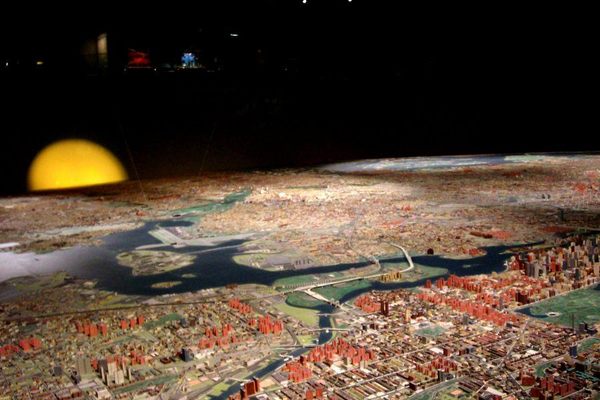Relics of the World’s Fair: Seattle
Preparing for the Seattle World’s Fair (via Seattle Municipal Archives)
After visiting Paris, Chicago, Barcelona, New York City, Montreal, St. Louis, and Melbourne, Atlas Obscura’s next stop in our tour of World’s Fair relics is Seattle, host to a fair in 1962.
World’s Fair Street Scene (via Seattle Municipal Archives)
Unlike other host cities, Seattle planned its infrastructure for the 1962 Century 21 Exposition to be a permanent city improvement. Seattle’s fair came shortly on the heels of a dramatic population and income boom, following the establishment of Boeing’s manufacturing plant in the city. However, many new Boeing workers settled in the suburbs, leaving Seattle’s downtown desolate. City planners hoped the 1962 fairgrounds could transition into a revitalized downtown civic and cultural center, rejuvenating the city itself.

World’s Fair Grounds Under Construction (via Seattle Municipal Archives)
Their gamble paid off — the entire fairgrounds, and most of its infrastructure, became today’s Seattle Center, a 74-acre park with museums, performance spaces, public art, and sports complexes. Also unlike other host cities, Seattle managed to turn a profit with its 1962 fair. Some of the original fairground have since been torn down or heavily remodeled, but a number still stand.
International Fountain at Night (via Seattle Municipal Archives)
The International Fountain, in the middle of the center, coordinates its jets of water to music. At times, the fountain’s keepers also project film and video images onto the water.
International Fountain at World’s Fair (via Seattle Municipal Archives)
The Pacific Science Center is housed in the former United States Science Pavilion from the 1962 fair. Some of the Science Center’s exhibits inside — including a model of the Earth’s moon — also date to the fair.
US World’s Fair Pavilion (photograph by Roger Wallstadt)
The eye-catching arches outside the center are also original to the fair, and are lit with different-colored lights at night to correspond with different holidays or special national or local events.
Arches at US Pavilion (photograph by Roger Wallstadt)
Seattle’s KeyArena sports stadium is on the site of the Washington State Pavilion. During Key Arena’s renovation, contractors made an effort to retain the “suspended roof” from the original building.
Key Arena (photograph by Jeramey Jannene)
Key Arena Roof (photograph by Jeramey Jannene)
Seattle’s monorail was built to provide public transit during the fair, and was retained for city use.
Seattle Monorail (via Seattle Municipal Archives)
Seattle’s Armory, built in 1939, was repurposed for the fair. Originally home to Seattle’s 146th Field Artillery, during the World’s Fair the Armory was host to a vertical shopping mall — the first such shopping center in the United States.
Seattle Center Armory (photograph by Doug Kerr)
Today, the Armory is home to Seattle’s Children’s Museum and to the Center House, a performing arts venue. On the second floor, the food court holds 14 restaurants by local vendors.
Horiuchi Mural, World’s Fair (via Seattle Municipal Archives)
The Seattle Mural, a 60-foot abstract mural by artist Paul Horiuchi, originally stood over a reflecting pool on the fairgrounds. Today it serves as the backdrop for the Mural Ampitheatre, an outdoor film and performance venue.
Space Needle at World’s Fair (via Seattle Municipal Archives)
Finally, Seattle’s Space Needle was built as an observation deck during the fair, and remains one of Seattle’s most iconic landmarks.
The original design also included two restaurants, which have since been combined into a single rotating eatery. At 605 feet in height, the Space Needle offers views not only of Seattle but also nearby Mount Rainer, Elliot Bay, and several of the islands in Puget Sound. At the time of its construction, the Space Needle was the tallest tower west of the Mississippi River.
Seattle from Space Needle (photograph by Roger Wallstadt)
World’s Fair Memorabilia (photograph by Ronald Douglas Frazier)
Below are more photographs from Seattle’s 1962 Century 21 Exposition:
Space Needle construction (via Seattle Municipal Archives)
Science Pavilion (via Seattle Municipal Archives)
Sign in downtown Seattle (via Seattle Municipal Archives)
World’s Fair signage (via Seattle Municipal Archives)
via Seattle Municipal Archives
Canada building (via Seattle Municipal Archives)
Electric Power Pavilion (via Seattle Municipal Archives)
General Motors exhibit (via Seattle Municipal Archives)
via Seattle Municipal Archives
Inside the Electric Power Pavilion (via Seattle Municipal Archives)
via Seattle Municipal Archives
International exhibits (via Seattle Municipal Archives)
Electric Power Pavilion (via Seattle Municipal Archives)
The entrance (via Seattle Municipal Archives)
World’s Largest Birthday Cake (via paulsedra/Flickr user)
Stay tuned for more in our series on World’s Fair relics, and be sure to visit Paris, Chicago, Barcelona, New York City, Montreal, St. Louis, and Melbourne.







Follow us on Twitter to get the latest on the world's hidden wonders.
Like us on Facebook to get the latest on the world's hidden wonders.
Follow us on Twitter Like us on Facebook